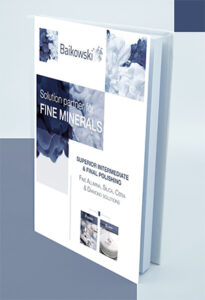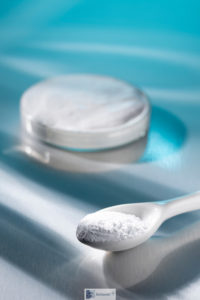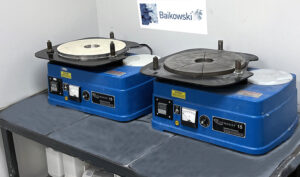How to choose your polishing materials?
 Polishing is the action of remove surface for the shortest time, while ensuring a high level of surface finish, fitting the application.
Polishing is the action of remove surface for the shortest time, while ensuring a high level of surface finish, fitting the application.
The polished substrate is the material on the surface of the device to be polished. Each substrate has its own intrinsic hardness, often measured on the Mohs scale (0 to 10).
The polishing process always implies a compromise between polishing speed (Removal Rate – RR) and surface finish. This will depend on the nature of the substrate to polish and especially its intrinsic hardness, and the polishing technique used.
Download our Polishing Catalog
Baikowski’s Alumina, Silica, Ceria and Diamond solutions polish substrates such as:

- Ceramics & Crystals: Our solutions are adapted for polishing a broad range of ceramic substrates, including spinel and other technical ceramics. For crystal materials such as sapphire, we tailor the polishing formulation to the crystallographic orientation to achieve optimal results. Learn more on our SPH slurry performance for sapphire polishing. These materials are widely used in watchmaking, optoelectronics, and semiconductor components.
- Glass: We offer ceria-based and alumina-based slurries for polishing high-performance glass parts used in optics, displays, and instrumentation.
- Metals: Baikowski® alumina powders are used for polishing precision metal parts and metallographic specimens, offering fast, clean surface preparation on materials like aluminum and copper.
- Organic Glass & Plastics: Materials such as PMMA or intraocular lenses benefit from alumina-based polishing systems that ensure gentle and defect-free surface finishing.
- Varnish & Lacquer: In applications such as car polish, our products are formulated into high-viscosity pastes or slurries to provide both effective cut and brilliant gloss during the superfinish stage.
- Dental prosthetics: Baikowski fine alumina Baikalox® products are used in polishing systems for denture bases, resin composites and ceramics, through coated abrasive disks, strips, rubber wheels, and points.
Discover our selection guide that will help you find the best solution for your substrates in our dedicated white paper.
Download our Polishing White Paper
Customized Polishing Solutions

Baikowski® Group offers customized polishing solutions tailored to your specific substrate and process, including powders, slurries, pastes, and custom formulations. For alumina powders far example, we optimize agglomeration for maximum efficiency, offering a range of options: spray-dried products, blends of fine alpha and gamma alumina particles, agglomerated alpha particles, and isolated alpha particles.
We precisely control particle size and distribution to achieve your desired surface finish and we can also adjust the alpha alumina content within a gamma alumina matrix. Our blog post, “the Superior Finishing Polishing Performance with Fine Alumina with high specific area vs. Colloidal Silica for soft metals in Metallography” demonstrates how fine alumina with high specific area improves surface finish, reduces polishing time, and simplifies cleaning.
For custom formulations, we fine-tune parameters like viscosity to complement abrasive performance. Our polishing materials are designed for versatile implementation across various media, and we optimize our abrasives to meet your specific application needs.
Baikowski® USA – Polishing Evaluation Services
Additionally, at our Charlotte Applications Lab in the US, Baikowski® provides abrasive polishing and grinding services for third parties. These services support customer feasibility studies, process development, and surface finish optimization.
Our lab is equipped with lapping and polishing tools to process a wide range of materials, such as:
- Ceramics & Crystals (e.g., sapphire polishing, wafer preparation)
- Glass components, including optical glass grinding to kiss polishing techniques
- Plastics, Metals, Varnish & Lacquers
- Film Forming Materials
Depending on the application, fine grinding or lapping steps may also be included as part of the service.

